Seagate BarraCuda 510 M.2 NVMe SSD Review: Competitive Performance Meets Bad Pricing
Why you can trust Tom's Hardware
512GB Performance Results
Comparison Products
Today we put Seagate’s BarraCuda 510 against several of the most popular SSDs available. At the high-end of the scale, we have the Samsung 970 EVO Plus, Adata XPG SX8200 Pro, Intel SSD 760p, and MyDigitalSSD BPX Pro. As the next step down, we have the Crucial P1, an SSD featuring QLC NAND, and the WD Blue SN500, a DRAMless TLC SSD. Finally, we’ve included performance results from a SATA Samsung 860 EVO to provide context.
ATTO
ATTO is a simple and free application that SSD vendors commonly use to assign sequential performance specifications to their products. It also gives us insight into how the device handles different file sizes.


Seagate’s BarraCuda 510 follows in the footsteps of MyDigitalSSD’s BPX Pro in this benchmark. The ADATA XPG SX8200 Pro and Samsung 970 EVO Plus are faster when it comes to smaller files, but the BarraCuda's sequential speeds of 3,450MB/s read and 2,100MB/s write prove it has enough speed to handle large file transfers with ease.
CrystalDiskMark
CrystalDiskMark (CDM) is a simple and easy to use file size benchmarking tool.
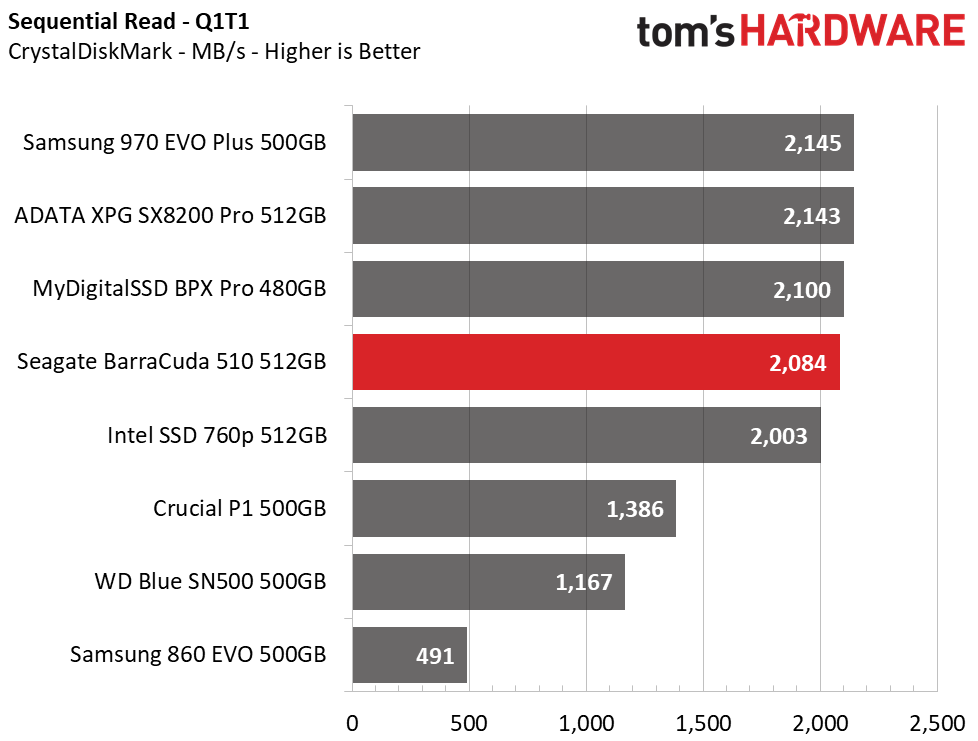
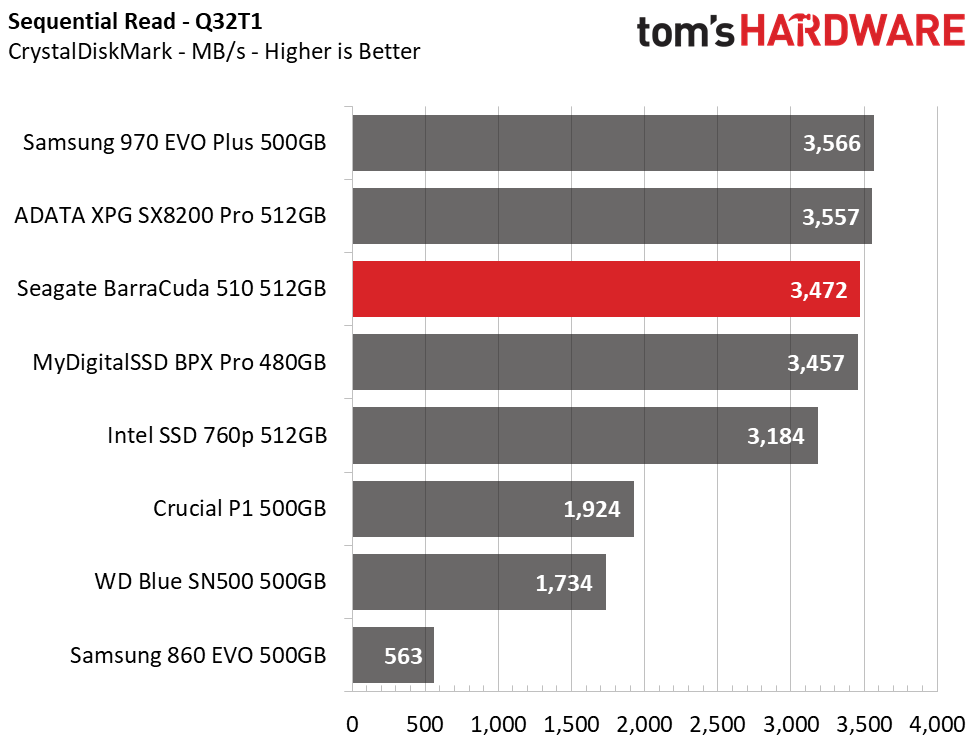





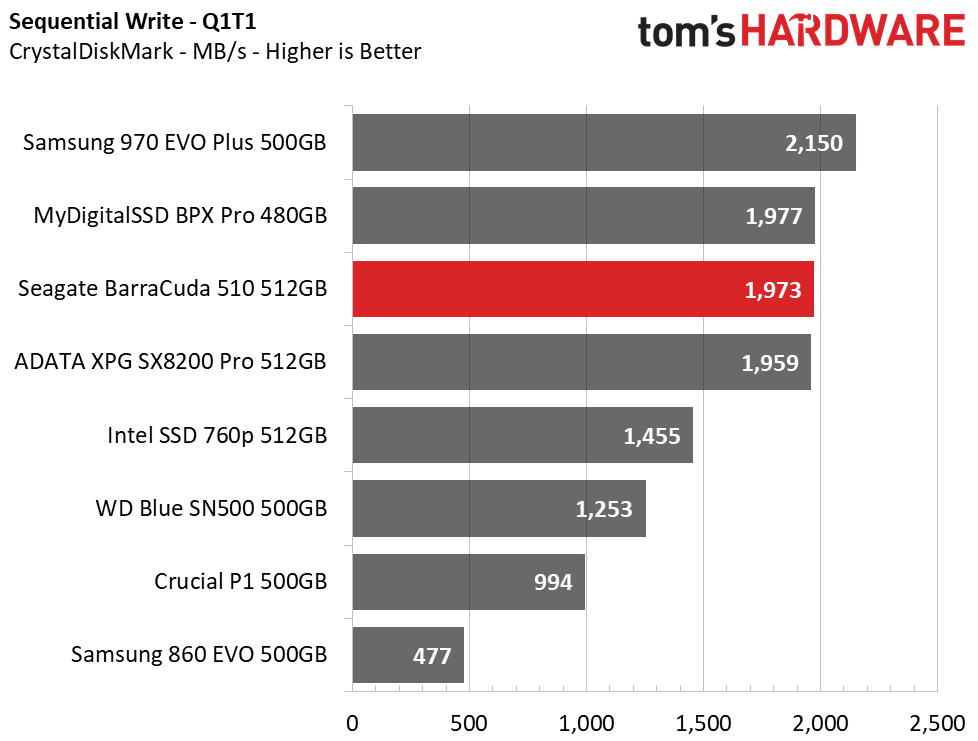

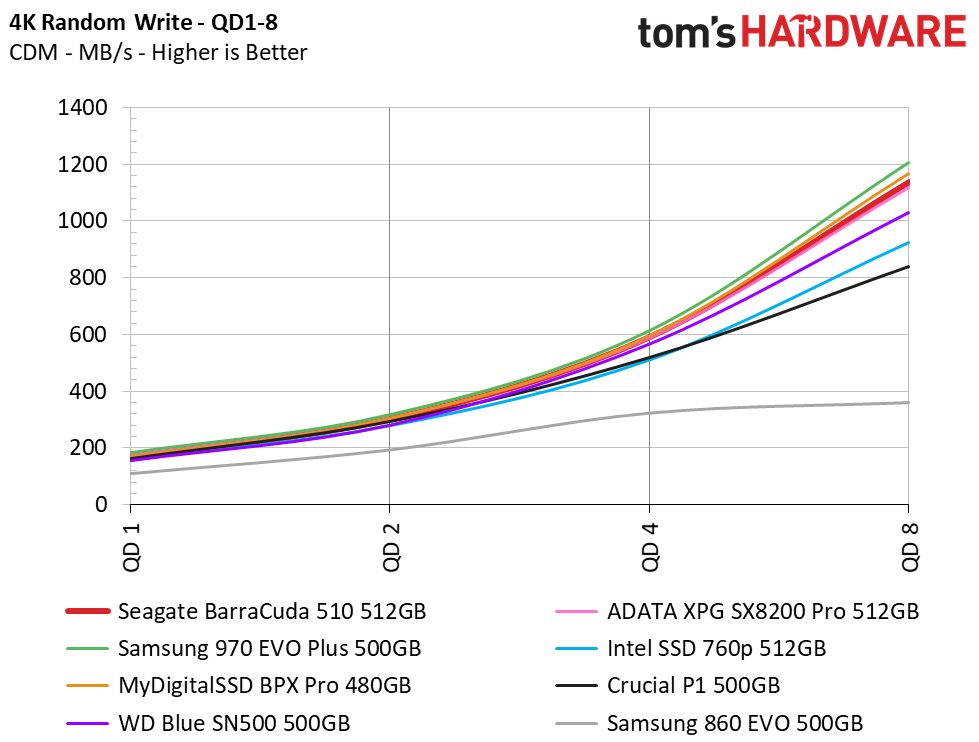
The BarraCuda 510 hits 3.4 GB/s read and 2.1 GB/s write speeds during our tests with sequential data. However, like most drives, this number deflates quickly to roughly 2.1/2 GB/s read/write at a queue depth (QD) of 1.
Random performance maxes out at 301,000/477,000 read/write IOPS at a QD of 64. This shows the controller’s capability; however, it doesn’t represent a metric that matters in real-world usage. At a more realistic QD1, the drive reads and writes at 13,000/43,000 IOPS and is comparable to most other SSDs up to a QD of 8.
Sustained Sequential Write Performance
Official write specifications are only part of the performance picture. Most SSD makers implement an SLC cache buffer, which is a fast area of SLC-programmed flash that absorbs incoming data. Sustained write speeds can suffer tremendously once the workload spills outside of the SLC cache and into the "native" TLC or QLC flash. We hammer the SSDs with sequential writes for 15 minutes to measure both the size of the SLC buffer and performance after the buffer is saturated.
Get Tom's Hardware's best news and in-depth reviews, straight to your inbox.



The Seagate BarraCuda 510 has an SLC cache, just as most other modern SSDs. The cache can absorb up to 13-14GB of writes before performance degrades from 2,250 MB/s down to 630 MB/s. This cache size is a bit smaller than the MyDigitalSSD BPX Pro’s cache, which gives the BPX Pro a small lead in overall write performance. The BPX Pro uses more overprovisioning to provide a larger SLC cache at the expense of usable capacity, while the BarraCuda 510 does the opposite.
Game Scene Loading - Final Fantasy XIV
The Final Fantasy XIV StormBlood benchmark is a free real-world game benchmark that easily and accurately compares game load times without the inaccuracy of using a stopwatch.
With a total game load time of 22 seconds, the BarraCuda 510 comes in eighth place overall. While this is significantly faster than an HDD, it is just slightly faster than a SATA SSD, and slightly slower than the other NVMe SSDs.
Transfer Rates – DiskBench
We use the DiskBench storage benchmarking tool to test file transfer performance with our own custom 50GB block of data. Our data set includes 31,227 files of various types, like pictures, PDFs, and videos. We copy the files to a new folder and then follow up with a read test of a newly-written 6GB file.


The BarraCuda does much better in our file transfer tests. Here it delivered an average transfer speed of 283MB/s during the 50GB file copy. However, the BarraCuda's performance was even better during our 6GB read test, where the drive took first place.
Trace Testing – PCMark 8 Storage Test 2.0
PCMark 8 is a trace-based benchmark that uses Microsoft Office, Adobe Creative Suite, World of Warcraft, and Battlefield 3 to measure the performance of storage devices in real-world scenarios.


Seagate’s BarraCuda 510 scores well in PCMark 8 – it is a high-end SSD indeed. It easily outperforms WD’s entry-level Blue SN500 and Crucial’s P1, as well as the SATA 860 EVO. With a total score of 5101 points, it ranks third place overall and even outperforms the Samsung 970 EVO Plus.
Application Testing - SYSmark 2014 SE
Like PCMark, SYSmark uses real applications to measure system performance. SYSmark takes things much further, however. It utilizes fourteen different applications to run real workloads with real data sets to measure how overall system performance impacts the user experience. BAPCo's SYSmark 2014 SE installs a full suite of applications for its tests, which includes Microsoft Office, Google Chrome, Corel WinZip, several Adobe software applications, and GIMP. That also makes it a great test to measure the amount of time it takes to install widely-used programs after you install a fresh operating system.
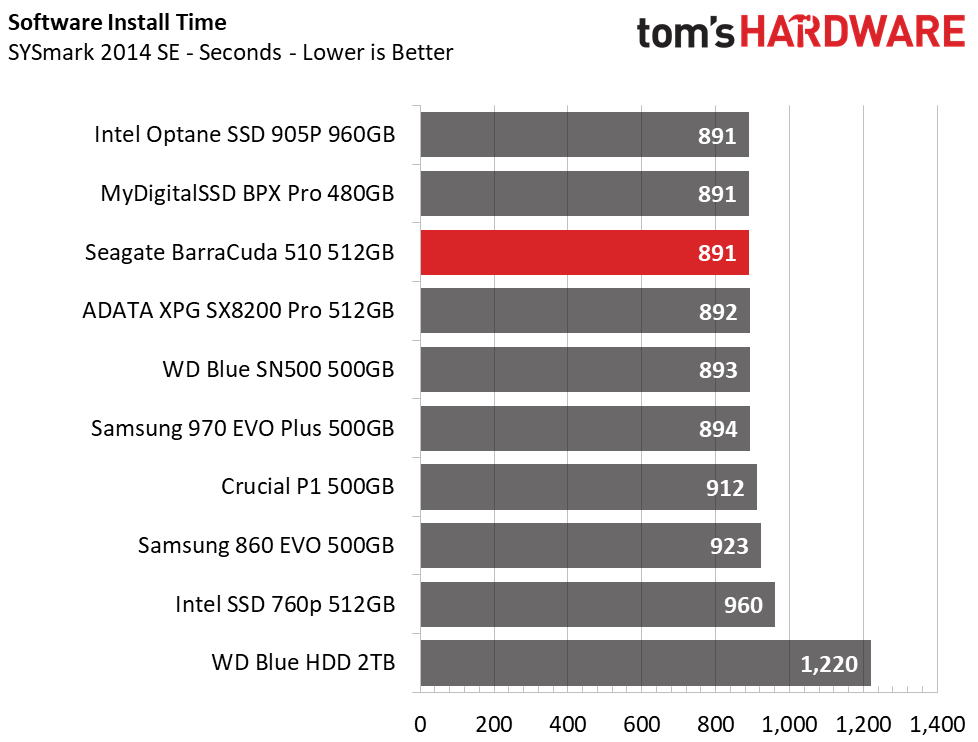
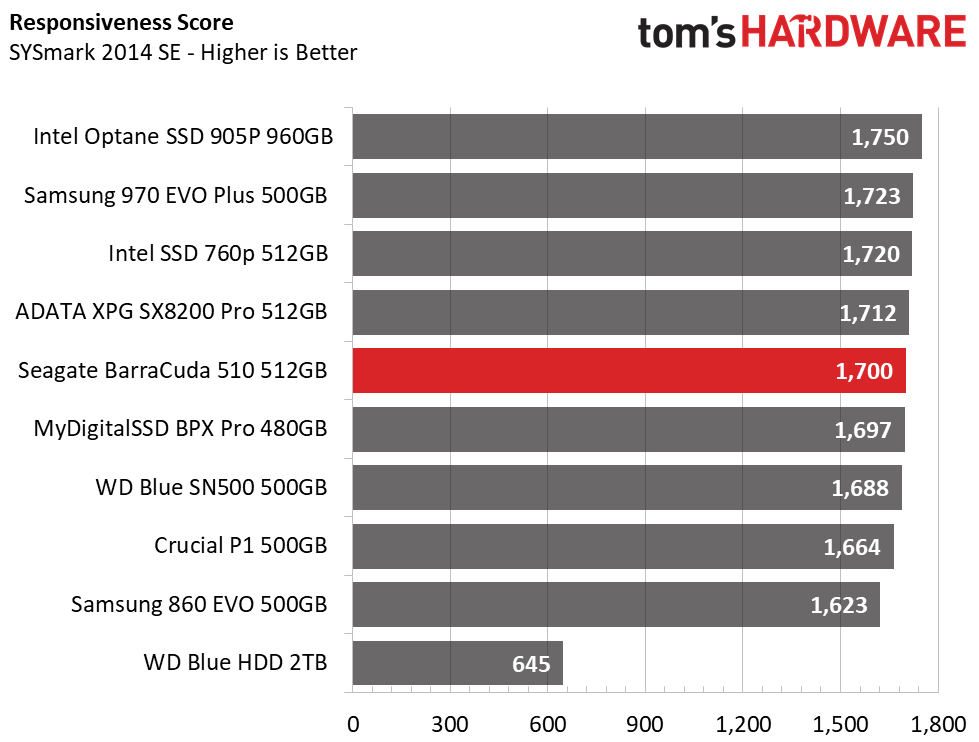
SYSmark installed in under 15 minutes and the total time required matched the Intel Optane SSD 905P. The BarraCuda scored 1,700 points in responsiveness, meaning it quite a performer in real-world workloads.
Power Consumption
We use the Quarch HD Programmable Power Module to gain a deeper understanding of power characteristics. Idle power consumption is a very important aspect to consider, especially if you're looking for a new drive for your laptop. Some SSDs can consume watts of power at idle while better-suited ones sip just milliwatts. Average workload power consumption and max consumption are two other aspects of power consumption, but performance-per-watt is more important. A drive might consume more power during any given workload, but accomplishing a task faster allows the drive to drop into an idle state faster, which ultimately saves power.

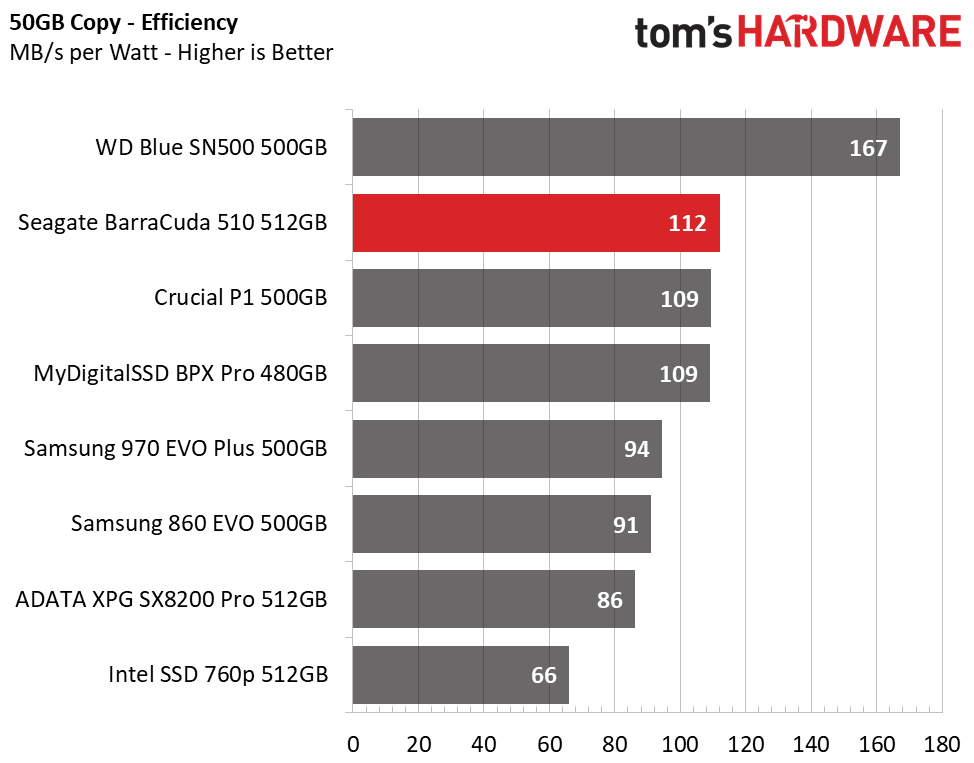



The Seagate BarraCuda 510 scores second in efficiency during our 50GB file transfer. With an average power consumption of 2.52W, it consumes about a watt less than the Samsung 970 EVO Plus.
Idle power consumption was also well regulated and on point for what we expected out of an E12-based SSD. With ASPM disabled, we measure it consuming 443mW of power, but when it was enabled, it consumed just 46mW.
MORE: Best SSDs
MORE: How We Test HDDs And SSDs
MORE: All SSD Content

Sean is a Contributing Editor at Tom’s Hardware US, covering storage hardware.



